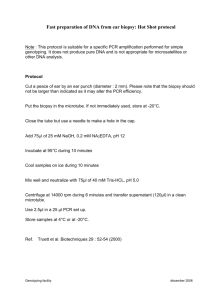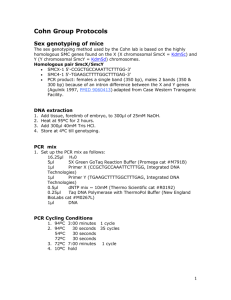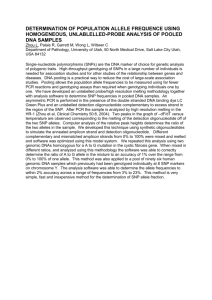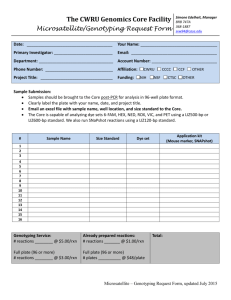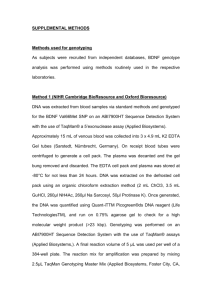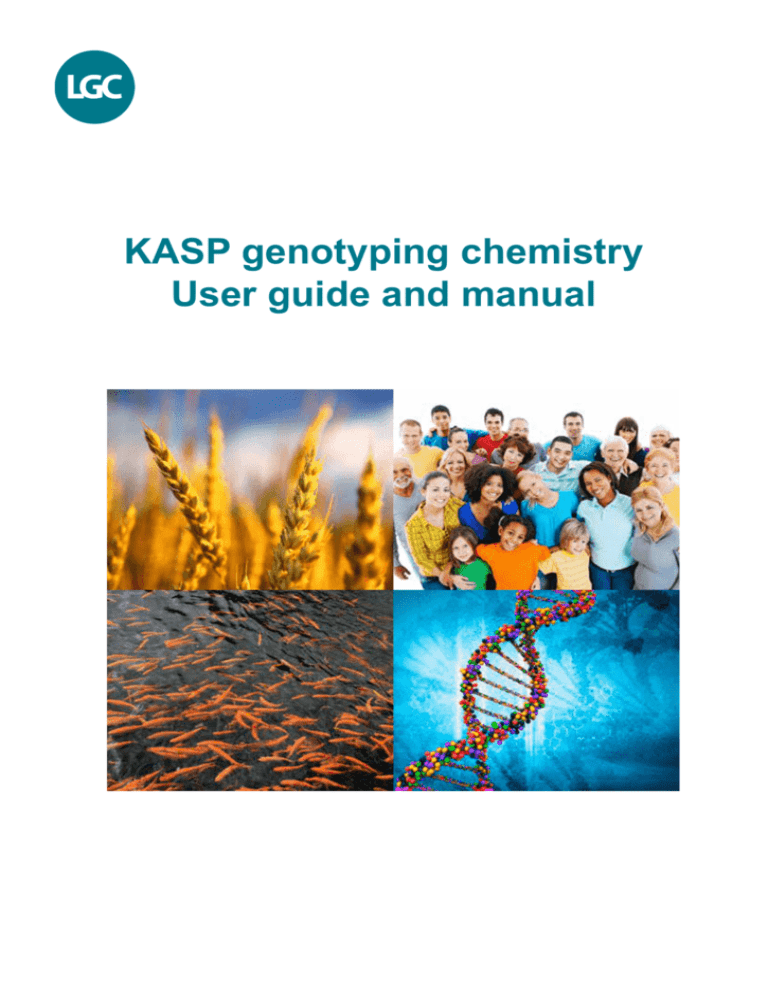
KASP genotyping chemistry
User guide and manual
KASP manual content
1. Introduction3
2. Principal of the KASP genotyping assay3
2.1
Mechanism of KASP chemistry4
3. The KASP reaction component5
3.1 Kit contents5
3.2 Customer requirements5
3.3 Storage and shelf life5
3.4 Sample arraying5
3.5 Negative controls5
3.6 Positive controls6
3.7 96- and 384-well plates6
3.8 1536-well plates6
3.9 DNA quantity / quality6
3.10 Drying down DNA samples6
4. Running KASP reactions7
4.1 Dispensing the KASP genotyping reagents7
4.2 Plates and plate sealing7
4.3 Thermal cycling conditions7
4.4 Plate reading7
4.5 Graphical viewing of genotyping data8
5. KASP trial kit 8
5.1 Validating the genotyping process8
2
KASP - User guide and manual
www.lgcgenomics.com
1. Introduction
The Kompetitive Allele Specific PCR genotyping system (KASPTM) is a homogeneous, fluorescent,
endpoint genotyping technology.
KASP offers the simplest, most cost-effective and flexible way to determine both SNP and insertion/deletion
genotypes. Analysis can be carried out in 96-, 384- and 1536-well plate formats.
The KASP genotyping system is comprised of two components:
1. The SNP specific KASP Assay mix, separately purchased as a KASP by Design (KBD) or KASP on Demand
(KOD) assay (http://www.lgcgenomics.com/genotyping/kasp-genotyping-reagents/kasp-assays-kbd-kod/)
2. The universal KASP Master mix, which contains all other required components including the universal
fluorescent reporting system and a specially developed Taq polymerase
(http://www.lgcgenomics.com/genotyping/kasp-genotyping-reagents/).
The KASP genotyping system has been used successfully in a wide variety of organisms, achieving well over
90% SNP to assay conversion rate.
2. Principal of the KASP genotyping assay
KASP
Master mix
KASP
Assay mix
Sample
DNA
KASP
genotyping
reaction
Refer to the website for full animation.
http://www.lgcgenomics.com/genotyping/kasp-genotyping-reagents/how-does-kasp-work/
www.lgcgenomics.com
KASP - User guide and manual
3
2.1 Mechanism of KASP chemistry
1) Assay components:
A) KASP Assay mix
B) KASP Master mix
allele-1
5’
allele-2
3’
5’
3’
C
5’
3’
5’
3’
3’
5’
3’
5’
A
Reverse primer:
3’
5’
5’
C) DNA template (sample)
3’
3’
5’
G/T
2) Denatured template and annealing components – PCR round 1:
5’
(allele-2 primer does not elongate)
A
Legend
3’
Allele-1 tail FAM-labelled
oligo sequence
Allele-2 tail HEX-labelled
oligo sequence
(reverse primer elongates 5’-3’)
(allele-1 primer binds and elongates)
Common reverse primer
C
F
FAM dye
In the first round of PCR, one of the allele-specific primers matches the target
SNP and, with the common reverse primer, amplifies the target region.
H
HEX dye
3) Complement of allele-specific tail sequence generated
– PCR round 2:
Q
3’
H Q
F Q
Allele-specific forward primers:
KASP uses three components:
test DNA with the SNP of
interest; KASP Assay mix
containing two different, allelespecific, competing forward
primers with unique tail
sequences and one reverse
primer; the KASP Master mix
containing FRET cassette
plus Taq polymerase in an
optimised buffer solution.
G
5’
C
G
Target SNP
Quencher
(Reverse primer binds, elongates
and makes a complementary copy
of the allele-1 tail.)
4) Signal generation – PCR round 3:
F
FAM-labelled oligo binds to new complementary tail
sequence and is no longer quenched.
Q
H Q
5’
3’
C
G
In further rounds of PCR, levels of allele- specific tail increase. The
fluor labelled part of the FRET cassette is complementary to new tail
sequences and binds, releasing the fluor from the quencher to generate
a fluorescent signal.
4
KASP - User guide and manual
3’
5’
Fluor for incorporated Fluor for non-incorporated
G allele no longer
T allele remains
quenched.
quenched.
www.lgcgenomics.com
3. The KASP reaction components
3.1 Kit contents
•
KASP Master mix (supplied at 2 x concentration),
The constituents of the KASP assay are:
containing Taq polymerase enzyme and the
KASP Assay mix
succinimidyl ester (ROX)
passive reference dye, 5-carboxy-X-rhodamine,
• Two allele-specific primers (one for each SNP
allele). Each primer contains a unique unlabelled tail
sequence at the 5' end.
•
MgCl2 (50 mM; for particularly A/T-rich DNA regions)
•
DMSO (for particularly G/C-rich DNA regions)
3.2 Customer requirements
• One common (reverse) primer.
1. FRET-capable plate reader1
The KASP Assay mix required to determine SNP
genotypes is purchased separately as KASP by Design
or KASP on Demand.
2. PCR microtitre plate
3. DNA samples (dissolved in Tris-HCl buffer
(10 mM; pH 8.3) or PCR grade H20
4. 10 mM Tris-HCl pH 8.3 or PCR grade H20
KASP by Design (KBD) represents the most costeffective access to the Assay mix, but is designed in-
5. Optical plate seal
1
Please contact LGC for advice on the choice of plate reader.
silico and not functionally validated prior to shipment.
3.3 Storage and shelf life
KASP on Demand (KOP) is a validated, optimised As-
KASP Master mix can be safely stored for one week at
say mix supplied by LGC and is guaranteed to generate
good genotyping data when used in conjunction with
4°C, one year at -20°C or indefinitely at -80°C.
If the KASP Master mix is divided into aliquots, it is
DNA of suitable quality and KASP Master mix.
recommended that the tubes used are light-protective;
100 μL of Assay mix is sufficient to carry out at least
Frequent freezing and thawing of both KASP Master
650 genotypes in 96-well format or at least 1300
genotypes in 384-well format (based on 10 μL and 5 μL
total assay volumes, respectively with plate type). The
KASP Assay mix is combined with the KASP Master
mix (see Table 1) and added to the DNA samples to be
genotyped.
assays may also be divided into convenient aliquots.
mix and assays will adversely affect performance.
3.4 Sample arraying
DNA samples may be arrayed in any microtitre PCR
plate though typically 96-, 384- or 1536-well plates
are used. The recommended amount of DNA to use
per reaction is 5 - 50 ng (see section 3.9 for details).
Genotyping should be carried out on at least 22
KASP Master mix
samples + 2 No-Template-Controls (NTCs) to ensure
• FAM™ and HEX™ specific FRET cassette
• Taq polymerase specially modified for allele-specific
PCR
there are sufficient genotypes to show clustering.
3.5 Negative controls
• Optimised buffer.
It is recommended that two NTCs are included on
each genotyping plate. A difference in fluorescent
Please check that the ROX level of your KASP MAter
signal intensity between the presence and absence
mix is compatiböe with your qPCR machine / plate
of template DNA allows improved confidence in the
reader.
validity of the genotyping results.
www.lgcgenomics.com
KASP - User guide and manual
5
3.6 Positive controls
3.9 DNA quantity / quality
When validating KASP Assay mix, and particularly
Most KASP assays will function well with 5-50 ng of
when working with a SNP that has low allele frequency,
high quality DNA per reaction. Genome size is also an
it is advisable to include positive controls i.e. DNA
important consideration as a greater mass of DNA per
samples of known genotype.
reaction will be required if genotyping a larger genome;
conversely, a smaller DNA mass per reaction will be
3.7 96- and 384-well plates
We recommend carrying out SNP genotyping using
total reaction volumes of 5 μL for 384-well or 10 μL for
96-well genotyping (see Table 1; any reduction to these
volumes may reduce the data quality and robustness).
The volumes in Table 1 must be proportionally scaled
up depending on the number of reactions required. It
is essential to combine KASP Master mix and KASP
Assay mix in sufficient quantities for all samples, rather
than attempting to pipette very small volumes of KASP
Assay mix and KASP Master mix into each well.
The final MgCl2 concentration of KASP Master mix
(v4.0) at 1x concentration is 2.5 mM. This is optimal
for the large majority of KASP Assay mixes. SNPs
that are located in particularly A/T-rich regions may
require more MgCl2, which should be added to a final
concentration of 2.8 mM.
Where the user prefers to dry down the arrayed DNA
samples (see section 3.10), the KASP Master mix must
be diluted by the addition of molecular biology grade
water, to bring the overall final mix concentration to 1x.
NB. Do not use the KASP chemistry at higher
required for smaller genomes.
The purity of DNA is important when using KASP but
no more so than for standard PCR. When DNA is
crudely extracted, inhibitors of PCR can potentially
remain, causing a greater or lesser issue depending
upon the source of the DNA and hence the nature of
the potential contaminants.
If the extracted DNA contains PCR inhibitors but is also
of high DNA concentration, it should be possible to dilute
it such that DNA concentration remains sufficiently
high, whilst effectively diluting out the inhibitors.
KASP can be used in conjunction with a variety of
DNA sources: genomic DNA, mitochondrial / bacterial
(haploid) DNA, nested PCR amplicons and whole
genome amplified (WGA) DNA.
For details of DNA extraction kits recommended by
LGC, please visit our website:
http://www.lgcgenomics.com/nucleic-acid-extraction/
kits/
3.10 Drying down DNA samples
Drying the DNA samples in the plate wells is a useful
final or lower final concentrations than 1x as the
technique when performing large-scale genotyping as
concentrations of the PCR reagents are critical.
it allows many plates of DNA to be prepared in advance
without the concern of sample evaporation which would
3.8 1536-well plates
Where genotyping is carried out in 1536-well plates,
KASP 1536 Master mix should be used in place of
the standard mix. KASP 1536 Master mix is specifically
optimised for use with the very low well volumes in
1536 plates.
6
otherwise alter the final reagent concentrations. Dried
DNA samples are stable at room temperature for at
least 3 months if protected from moisture. To dry the
DNA samples, after arraying, the plates should be briefly
centrifuged and placed in a drying oven at around 55°C
for one hour.
KASP - User guide and manual
www.lgcgenomics.com
Table 1. Constituent reagent volumes for making KASP
genotyping mix. *DNA samples diluted to final concentration
of 5 - 50 ng per reaction.
KASP genotyping mix assembly
Table 2: Thermal cycling conditions for KASP chemistry
94°C for 15 minutes
Hot-start activation
94°C for 20 seconds
61-55°C for 60 seconds
(dropping 0.6°C per cycle)
10 cycles
94°C for 20 seconds
55°C for 60 seconds
26 cycles
Components
Wet DNA
method (μL)
DNA*
2.5
5
N/A
N/A
2x Master mix
2.5
5
2.5
5
Primer mix
0.07
0.14
0.07
0.14
H2O
N/A
N/A
2.5
5
If using a Peltier block-based thermal cycler, ensure
5
10
5
10
that the PCR plate type is correct for the block being
Total reaction
volume
Dry DNA method
(μL)
The KASP thermal cycling program is as follows:
All reagents should be briefly vortex-mixed prior to use.
used, as incorrect fit can cause uneven PCR and
variation of resultant data quality across the plate.
4. Running KASP reactions
If clear genotyping clusters have not been obtained,
4.1 Dispensing the KASP genotyping
reagents
again. Please see Table 3 for recycling conditions.
the plate should be thermally cycled further and read
Dispensing can be carried out robotically or manually
with a suitable pipette, depending on plate type and
sample number. Please contact customer service
about our liquid dispensing systems.
4.2 Plates and plate sealing
For 96- and 384-well plate formats, we recommend
the use of the Kube™ heat-based plate sealer. Plate
sealing can also be achieved with an optically-clear
seal. For black 384- and especially 1536-well plates,
we recommend the Fusion3™ laser welding system.
For further information on these and other products
please contact us.
Table 3: Conditions for further thermal cycling of the KASP
chemistry
Step
Temperature
Time
Denature
94OC
20 sec
Annealing /
Elongation
57OC
60 sec
Number of
cycles per step
3 cycles
4.4 Plate reading
Most FRET-capable plate readers (with the relevant
filter sets) can be used in conjunction with KASP.
temperatures but elevated temperatures (above 40°C)
The KASP chemistry can be used with any standard
thermal cycler. Similar results have been obtained
on Peltier block-based thermal cyclers and our
Hydrocycler™ water bath-based thermal cyclers. KASP
uses a set of thermal cycling conditions comprised of
two temperature steps, rather than the more traditional
three steps. In this protocol the DNA is denatured at
the higher temperature and annealed and extended at
www.lgcgenomics.com
genotyping clusters have been obtained.
Some plate readers can be set to read at a range of
4.3 Thermal cycling conditions
the same (lower) temperature.
Further cycling and reading can be performed until tight
will lead to poor quality data.
Because of the underlying mechanism of the
KASP chemistry, care should be taken that KASP
genotypes are only analysed at ≤ 40°C.
Whilst using real-time PCR machines, plates should
be read at ≤ 40°C after the completion of the PCR run
rather than using the real time data to generate end
point curves.
KASP - User guide and manual
7
KASP uses the fluorophores FAM and HEX for
distinguishing genotypes. The passive reference dye
5. KASP trial kit
ROX is also used to allow normalisation of variations
5.1 Validating the genotyping process
in signal caused by differences in well-to-well liquid
Before using the KASP genotyping chemistry for the
volume (see Figure 1). The relevant excitation and
first time, it is recommended (though not necessary) to
emission wavelengths are shown in Table 4.
contact us for a free-of-charge KASP trial kit. In general
Table 4. Excitation and Emission values for the fluors
used in KASP. If using a plate reader optimised for use with
the dye VIC, no modification of settings will be necessary
as the excitation and emission values for VIC and HEX are
extremely similar.
Fluorophore
Excitation (nm) Emission (nm)
any qPCR plate reader instrument that is capable of
reading FRET at the wavelengths in Table 4 should be
compatible with KASP.
The KASP trial kit contains a plate of 33 DNA samples
prediluted to a concentration range appropriate for
FAM
485
520
KASP genotyping reactions and 3 No-Template-
HEX
535
556
Controls (NTCs) in wells A12, B12 and C12.
ROX
575
610
4.5 Graphical viewing of genotyping data
We offer a data analysis software package either as
part of a full Workflow Management system (Kraken™)
or a scaled-down version (KlusterCaller™). In our
software, the FAM and HEX data are plotted on the
x- and y-axes respectively. Inclusion of a passive
reference dye (ROX) allows data to be normalised by
dividing FAM and HEX values by the passive reference
value for that particular well, thus removing the variable
of liquid volume. Genotypes can then be determined
according to sample clusters (Figure 1). The inclusion
of a passive reference leads to tighter clustering and,
FAM allele reported on X axis
HEX allele reported on Y axis
HEX allele reported on Y axis
as a result, more accurate calling of data.
KASP assay in a 2-D barcoded tube. To run the test
assay on the trial kit DNA samples, please follow the
procedures set out in Section 4 of this manual and
refer to the KASP genotyping trial kit guide for full
instructions.
When genotyped with the test assay, the validation
DNA samples will give rise to the three observable
genotyping groups, respectively FAM (homozygote),
HEX (homozygote) and FAM / HEX (heterozygote).
Successful completion of these tests demonstrates that
the plate reader, thermocycler and genotyping procedure are suitable for use with the KASP chemistry.
Please visit our website to request your free-of-charge
KASP trial kit: http://www.lgcgenomics.com/tryit/
For any queries about this guide please contact:
FAM allele reported on X axis
Figure 1. Genotyping data plotted using KlusterCaller software.
The same data can be viewed without normalisation with ROX
(left figure) or with normalisation (right figure). Genotyped samples marked red are homozygous for the allele reported with HEX,
those marked blue are homozygous for the FAM allele and those
marked green are heterozygous.
8
Also included in the kit is an aliquot (50 μL) of test
All locations except USA:
email tech.support@lgcgenomics.com
or call +44 (0)1992 476 486
USA only: email us-support@lgcgenomics.com
KASP - User guide and manual
or call +1 978 338 5317
www.lgcgenomics.com
Products and services overview
Genotyping
- KASPTM genotyping reagents and services
- SNPlineTM high-throughput PCR workflow instrumentation
Extraction
- DNA and RNA extraction services
- DNA extraction products (sbeadexTM, KleargeneTM and mag™ kits)
- Extraction automation instruments (oKtopureTM and GenespinTM)
Sequencing
- Sanger sequencing
- Next-generation sequencing services (Roche 454, Illumina HiSeq & MiSeq)
Other valuable tools
- Enzymes and PCR reagents (KlearKall, KlearTaqTM, KlearTaqTM HiFi)
- Whole Genome Amplification (WGA) kits and services
- DNA shearing instruments (Covaris)
- Heat and laser sealing films (96-, 384- & 1536-well plates)
For further information please visit our webpage
www.lgcgenomics.com
Tel: +49 (0)30 5304 2200
Fax: +49 (0)30 5304 2201
Email: info.de@lgcgenomics.com
www.lgcgenomics.com
United Kingdom
Unit 1-2 Trident Industrial Estate • Pindar Road
Hoddesdon • Herts • EN11 0WZ
Tel: +44 (0) 1992 470757
Fax +44 (0) 1438 900670
Email:
KASPinfo.uk@lgcgenomics.com
- User guide and manual
USA
100 Cummings Center • Suite 420H
Beverly • MA 01915
Tel: +1 (978) 232 9430
Fax: +1 (978) 232 9435
Email: info.us@lgcgenomics.com
9
No part of this publication may be reproduced or transmitted in any form or by any means, electronic or mechanical, including photocopying,
recording or any retrieval system, without the written permission of the copyright holder. © LGC Limited, 2013. All rights reserved.
245/1.00/2013-07
LGC
Germany
Ostendstr. 25 • TGS Haus 8
12459 Berlin

